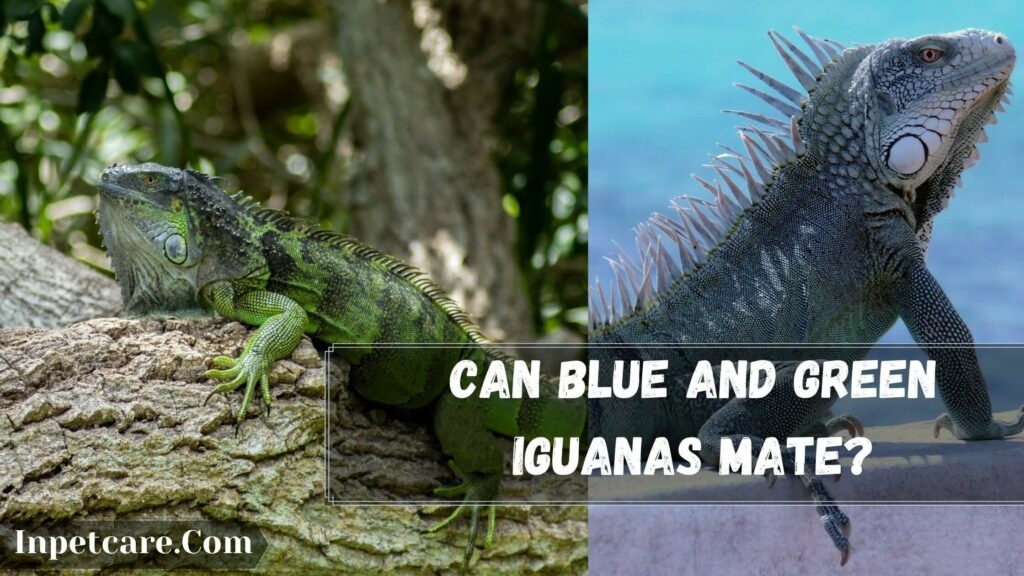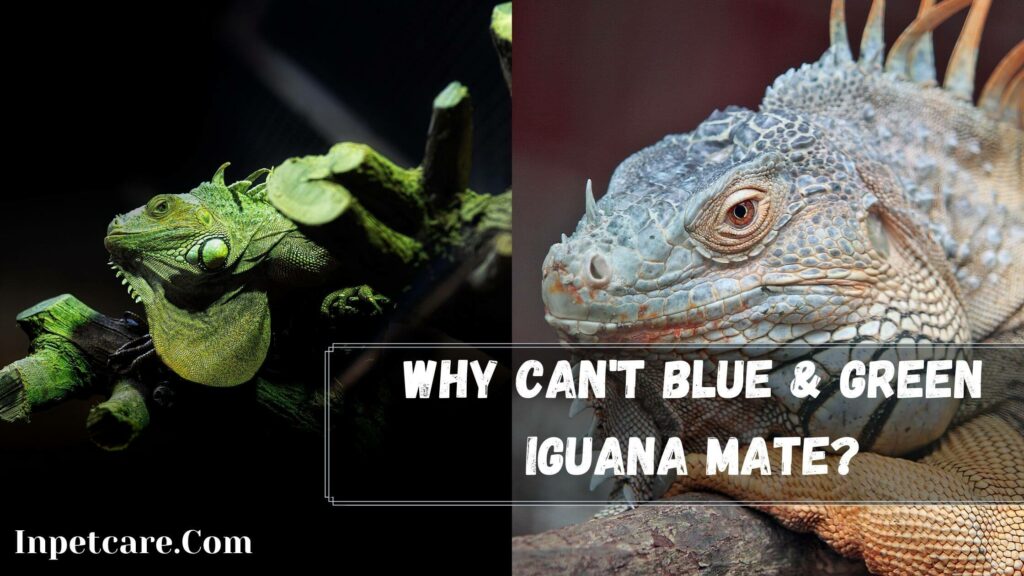Nowadays, it has been a trend to keep reptiles at home. According to an estimate, over 7.3 million households own reptiles in the United States. On the other hand, around 50-55 million households with cats and dogs as pets in the United States.
Hence, it’s clear that reptiles are being adopted as pets rapidly and becoming a favorite among pet owners. Therefore, it’s no surprise that you or an individual might think of crossbreeding green iguanas with blue iguanas. In this article, I will answer a very interesting question: can blue and green Iguanas mate? We will also look at whether you can crossbreed Iguana or not.
Post Contents
Can you cross breed iguanas?
Crossbreeding any Iguana has never been considered possible. When it comes to reptiles, crossbreeding is the only credible interpretation. Due to having genetic differences between two different species of Iguana, crossbreeding is not possible.
However, a first-generation hybrid Iguana was bred after the practice of intergeneric breeding between a female Galapagos land Iguana and a male Marine Iguana. Galapagos Islands of South plaza Island is where these two species’ territories overlap. Now let’s take a quick look at can blue and green iguanas, mate. Let’s Know: Can Blue And Green Iguanas Mate?
Can Blue And Green Iguanas Mate?

No. Green and blue iguanas can never mate because they are completely different species with lots of genetic differences that prevent such mating and the birth or production of hybrids.
Do you know that blue iguanas are one of the largest heavy-bodied lizards around the globe, whose color range from grey to bright blue? They hail from the Cayman Islands and are also popularly known as Grand Cayman iguanas.
Like any reptile or some species of iguanas, they are also diurnal and love basking in the direct sunlight to warm up at the start of the day. Do you know that blue Iguana in the red list by IUCN? There is only 443 mature blue Iguana living around the globe, making them endangered.
Currently, it is illegal to keep blue iguanas as pets as they’re on the endangered category in the IUCN red list. However, according to a recent survey, their population numbers have been increasing in the present world.
On the other hand, green iguanas are among the most popular and common Iguanas that every owner will inevitably want to breed and keep as pets. Did you know that it can be difficult to breed iguanas in captivity?
A breeding specialist must perform iguana breeding because highly skilled herpetologists work consistently to reproduce, even in some zoos. Even if you successfully breed and get the fertile eggs, oviposition and incubation will be another obstacle you will need to encounter.
Most of the iguanas vastly sold in your nearest Pet store are captive-born. Do you know that female Iguana are capable of reproductively cycling and ovulating without the presence of a male? In chickens, we always want to ovulate the eggs as we want to eat them, but for iguanas in captivity, we will have to do the opposite.
If you are breeding, you will never enjoy their eggs ovulating. Ovulation while laying eggs is often fraught with medical problems. Therefore, reproduction or breeding of Iguana is overall a complicated process that must be performed under the supervision of an experienced breeder.
The whole reproduction in the Iguana involves the interplay between humidity season, light cycles, temperature, and adequate nesting area. All the iguanas are sold under the label beginner pet, but they are not. Let’s talk about the reproduction of both species of Iguana to know why they cannot mate with each other. After Knowing, Can Blue And Green Iguanas Mate or Not, Let’s know why so?
Why Can’t Blue & Green Iguana Mate?

Blue iguanas can never mate with green Iguanas due to having different genetics and reproduction systems. This type of mating or breeding should never be practiced as it will only result in worse.
Reproduction of blue iguanas
The normal mating between blue Iguana usually takes place in the month of may to throughout June. At that period, it is common to see this male blue Iguana bobbing its head while cycling around behind the female blue Iguana to attract them.
Soon, blue iguanas will grasp the female’s neck’s nape to restrain her and maneuver their tail under hers to position themselves better for copulation. The copulation period generally lasted from 30-90 seconds. Plus, they rarely mate more than once or twice a day.
Breeding Blue Iguana is a hectic task that should be done under the supervision of experts and veterinarians. Like any other reptile, the blue Iguana also lays eggs in clutches. In a clutch, they can lay from anywhere 1-21 eggs at a time.
The number of eggs laid in a clutch by the female blue iguanas usually varies depending upon her size and age. They prefer laying their eggs in nests excavated in pockets of Earth exposed to direct sunlight. Normally, a blue Iguana lays eggs in June or July.
They prefer burrowing their eggs in 16-60 inches in length deep burrows with a huge chamber at its terminal portion to allow them to turn around. After laying eggs, blue iguanas usually abandon their eggs and let them hatch on their own.
The temperature for the eggs to hatch should be constant at around 85-90° F throughout the incubation period. The incubation period of Iguana eggs usually lasts from 65 to 90 days. Whether you know it or not, blue iguanas eggs are among the largest laid eggs by any lizard around the globe.
Blue Iguanas tend to be very aggressive when they are 3 months of age. Sexual maturity usually comes at the age of 3-4 years, depending upon many factors if kept in captivity.
reproduction of green iguanas
In the mating season, male green Iguana usually displays more dominant behavior to attract females. They will often perform unusual behavior like tail whipping or head bobbing to catch the opposite sex of the same species’ attention.
Additionally, male green Iguana also comes with highly developed female pores situated on their thighs’ underside. These femoral pores are to secrete a scent that helps in attracting the females in the wild. Female green iguanas also have femoral pores but are usually of a smaller size.
In addition, male green Iguana also has large, round, and very pronounced jocks. Jowls are generally protected by the subtympanic plate and are located under the jaw. The subtympanic plate is a large, green, and circular-shaped scale. Male iguanas also have a taller dorsal crest than females and spines or spikes.
Their dorsal spine runs along its back which is noticeably longer and thicker in males than females. Being oviparous, female green Iguana usually eggs once a year in a clutch. In a single clutch, female green iguanas can lay around 20-71 eggs at a time during a synchronized nesting period.
After laying her eggs in the burrow, the female pays no attention to parental protection apart from defending the nest or burrow during excavation. In many areas of Panama, green Iguana has been seen sharing nests or burrows with American crocodiles.
Their eggs need around 10-15 weeks of incubation to hatch properly. Hatchlings of green Iguana usually look similar to adults in shape and color. However, the hatchling will lack dorsal spines. For the first year of their lives, young green Iguana hatchlings will stay in familial groups and use their own body to protect and shield females from predators.
Interesting Further Reading:
- Taking Care Of A Blue Iguana
- What Can Green Iguana Eat? (21+ Safe Foods)
- Will Iguanas Eat Mushrooms? 5 Risks involved
I’ve given my best to provide all ideas and knowledge on the question: Can Blue And Green Iguanas Mate. If you’ve any other concern or looking to know more than only knowing Can Blue And Green Iguanas Mate, check our Iguanas’ Care Category.

94% of pet owners say their animal pal makes them smile more than once a day. In 2007, I realized that I was made for saving Animals. My father is a Vet, and I think every pet deserves one. I started this blog, “InPetCare”, in 2019 with my father to enlighten a wider audience.
